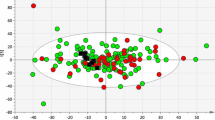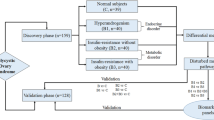Abstract
Background: Polycystic ovary syndrome (PCOS) and congenital adrenal hyperplasia (CAH) represent the most common causes of hyperandrogenism. Although the etiopathogeneses of these syndromes are different, they share many clinical and biochemical signs, such as hirsutism, acne, and chronic anovulation. Experimental data have shown that peripheral T-lymphocytes function as molecular sensors, being able to record molecular signals either at staminal and mature cell levels, or hormones at systemic levels. Methods: Twenty PCOS women and 10 CAH with 21-hydroxylase deficiency, aged between 18–35 yr, were studied. T-cells purified from all patients and 20 healthy donors have been analyzed by 2-dimensional gel electrophoresis. Silver-stained proteomic map of each patient was compared with a control map obtained by pooling protein samples of the 20 healthy subjects. Results: Spots of interest were identified by peptide mass fingerprint. Computer analysis evidenced several peptidic spots significantly modulated in all patients examined. Some proteins were modulated in both syndromes, others only in PCOS or in CAH. These proteins are involved in many physiological processes as the functional state of immune system, the regulation of the cytoskeleton structure, the oxidative stress, the coagulation process, and the insulin resistance. Conclusion: Identification of the physiological function of these proteins could help to understand ethiopathogenetic mechanisms of hyperandrogenic syndromes and its complications.
Similar content being viewed by others
References
Azziz R, Carmina E, and Sawaya ME. Idiopathic hirsutism. Endocrine Review 2000, 21: 347–62.
Norman RJ, Dewailly D, Legro RS, Hickey TE. Polycystic ovary syndrome. Lancet 2007, 25: 685–97.
Kuttenn F, Couillin P, Girard F, et al. Late-onset adrenal hyperplasia in hirsutism. N Engl J Med 1985, 313: 224–31.
Riepe FG, Sippell WG. Recent advances in diagnosis, treatment, and outcome of congenita adrenal hyperplasia due to 21-hydroxylase deficiency. Rev Endocr Metab Disord 2007, 8: 349–63.
Speiser PW, White PC. Congenital adrenal hyperplasia. N Engl J Med 2003, 349: 776–88.
Fratantonio E, Vicari E, Pafumi C, Calogero AE. Genetics of polycystic ovarian syndrome. Reprod Biomed Online 2005, 10: 713–20.
Sahin Y, Kelestimur F. The frequency of late-onset 21-hydroxylase and 11-hydroxylase deficiency in women with polycystic ovary syndrome. Eur J Endocrinol 1997, 137: 670–4.
Gladkevich A, Kauffman HF, Korf J. Lymphocytes as a neuronal probe: potential for studying psychiatric disorders. Prog Neuro-psychopharmacol Biol Psychiatry 2004, 28: 559–76.
Hatch R, Rosenfield RL, Kim MH, Tredway D. Hirsutism: implications, ethiology, and management. Am J Obstet Gynecol 1981, 140: 815–30.
Ehrmann DA, Barnes RB, Rosenfield RL. Polycystic ovary syndrome as a form of functional ovarian hyperandrogenism due to dysregulation of androgen secretion. Endocr Rev 1995, 16: 322–53.
Schmidt NA, Borburg HJ, Penders TJ, Wejcamp CW. Steroid profiling—an update. Clin Chem 1985, 31: 637–9.
Wilson RC, Wei JQ, Cheng KC, Mercado AB, New MI. Rapid deoxyribonucleic acid analysis by allele-specific polimerase chain reaction for detection of mutations in the steroid 21-hydroxylase gene. The Jour 1995, 80: 1635–40.
Shevchenko A, Wilm M, Vorm O, Mann M. Mass spectrometric sequencing of proteins silver-stained polyacrylamide gels. Anal Chem 1996, 68: 850–8.
Huang TY, DerMardirossian C, Bokoch GM. Cofilin phosphatases and regulation of actin dynamics. Curr Opin Cell Biol 2006, 18: 26–31.
Zigmond SH. Beginning and ending an actin filament: control at the barbed end. Curr Top Dev Biol 2004, 63: 145–88.
Hall A. Rho GTPases and the control of cell behaviour. Biochem Soc Trans 2005, 33: 891–5.
Miletic AV, Swat M, Fujikawa K, Swat W. Cytoskeletal remodelling in lymphocyte activation. Curr Opin Immunol 2003, 15: 261–8.
Pancholi V. Multifunctional alpha-enolase: its role in diseases. Cell Mol Life Sci 2001, 58: 902–20.
Rhee SG, Chae HZ, Kim K. Peroxiredoxins: a historical overview and speculative preview of novel mechanisms and emerging concepts in cell signalling. Free Radic Biol Med 2005, 38: 1543–52.
Liaudet-Coopman E, Beaujouin M, Derocq D, et al. Cathepsin D: newly discovered functions of a long-standing aspartic protease in cancer and apoptosis. Cancer Lett 2006, 237: 167–79.
Yeung KC, Rose DW, Dhillon AS, et al. Raf kinase inhibitor protein interacts with NF-kappaB-inducing kinase and TAKI and inhibits NF-kappaB activation. Mol Cell Biol 2001, 21: 7207–17.
Loupatty FJ, van der Steen A, Ijlst L, et al. Clinical, biochemical, and molecular findings in three patients with 3-hydroxyisobutyric aciduria. Mol Genet Metab 2006, 87: 243–8.
Wilkinson B, Gilbert HF. Protein disulfide isomerase. Biochim Biophys Acta 2004, 1699: 35–44.
Miller AF. Superoxide dismutase: active sites that save, but a protein that kills. Curr Opin Chem Biol 2004, 8: 162–8.
Ohkawa R, Hirowatari Y, Nakamura K, et al. Platelet release of beta-thromboglobulin and platelet factor 4 and serotonin in plasma samples. Clin Biochem 2005, 38: 1023–6.
Padmanabhan B, Kuzuhara T, Adachi N, Horikoshi M. The crystal structure of CCG1/TAF(II)250-interacting factor B (CIB). J Biol Chem 2004, 279: 9615–24.
Scandalios JG. Oxidative stress: molecular perception and trasduction of signals triggering antioxidant gene defences. Brazilian Journal of Medical and Biological Reserce 2005, 38: 995–1014.
Jäger S, Groll M, Huber R, Wolf DH, Heinemeyer W. Proteasome beta-type subunits: unequal roles of propeptides in core particle maturation and a hierarchy of active site function. J Mol Biol 1999, 291: 997–1013.
Pan Z, Wang J, Yin X, et al. The function study on the interaction between Grb2 and AMPK. Mol Cell Biochem, 307: 121–7.
Hanash S. Disease proteomics. Nature 2003, 422: 226–32.
Samy TS, Knöferl MW, Zheng R, Schwacha MG, Bland KI, Chaudry IH. Divergent immune responses in male and female mice after trauma-hemorrhage: dimorphic alterations in T lymphocyte steroidogenic enzyme activities. Endocrine 2001, 142: 3519–29.
Utz PJ. Protein arrays for studyng blood cells and their secreted products. Immunol Rev 2005, 204: 264–82.
Chen DS, Davis MM. Molecular and functional analysis using live cell microarrays. Curr Opin Chem Biol 2006, 10: 28–34.
Hughes C, Elgasim M, Layfield R, Atiomo W. Genomic and post-genomic approaches to polycistic ovary syndrome-progress so far: Mini review. Hum Reprod 2006, 21: 2766–75.
Anderson NL, Anderson NG. The human plasma proteome: history, character, and diagnostic prospects. Mol Cell Proteomics 2002, 1: 845–67.
Wood JR, Dumesic DA, Abbott DH, Strauss JF 3rd. Molecular abnormalities in oocytes from women with polycystic ovary syndrome revealed by microarray analysis. J Clin Endocrinol Metab 2007, 92: 705–13.
Ma X, Fan L, Meng Y, et al. Proteomic analysis of human ovaries from normal and polycystic ovarian syndrome. Mol Hum Reprod 2007, 13: 527–35.
Boden G, Duan X, Homko C, et al. Increase in endoplasmic reticulum stress-related proteins and genes in adipose tissue of obese, insulin-resistant individuals. Diabetes 2008, 57: 2438–44.
Kusçu NK, Var A. Oxidative stress but not endothelial dysfunction exists in non-obese, young group of patients with polycystic ovary syndrome. Acta Obstet Gynecol Scand 2009, 88: 612–7.
Barati MT, Merchant ML, Kain AB, Jevans AW, McLeish KR, Klein JB. Proteomic analysis defines altered cellular redox pathways and advanced glycation end-product metabolism in glomeruli of db/db diabetic mice. Am J Physiol Renal Physiol 2007, 293: 1157–65.
Author information
Authors and Affiliations
Corresponding authors
Additional information
SM and AS gave equal contribution to this work
Rights and permissions
About this article
Cite this article
Misiti, S., Stigliano, A., Borro, M. et al. Proteomic profiles in hyperandrogenic syndromes. J Endocrinol Invest 33, 156–164 (2010). https://doi.org/10.1007/BF03346575
Accepted:
Published:
Issue Date:
DOI: https://doi.org/10.1007/BF03346575




